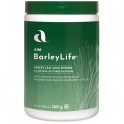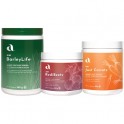Learn how nano glutathione can help you age gracefully by neutralizing harmful free radicals, supporting a robust...
Blog Search
Blog tags
Green drinks, fast food of the future
Millions of people consume herbal juices for their health, but not the kind of grass that forms your lawn.
By Frank Bredell
Grass juice is rich in chlorophyll, vitamins, minerals, proteins and enzymes, all of which are essential for complete nutrition.
Chlorophyll, chemically very similar to human blood, has been called "oxygenated liquid sunshine".
You don't have to drink grass juice to consume chlorophyll, it is present in all dark green plants. But as Dr. Mary Ruth Swope, a nutritionist, so aptly puts it, "How many servings of cabbage leaves, turnip or mustard tops, spinach or even beet greens have you eaten this week? "
In addition to chlorophyll, green grass juice contains high amounts of vitamins C, B1, B2, B3, pantothenic acid, folic acid, carotene (the safe way to get vitamin A) and choline. The juice is also rich in potassium, calcium, magnesium, iron, copper, phosphorus and manganese.
Potassium is especially important because it helps control the amount of sodium in the body and certain types of sodium are commonly considered a cause of high blood pressure.
Minerals also maintain the balance between acidity and alkalinity in our bodies. If there is an imbalance, cellular metabolism is affected and this can lead to exhaustion and other health problems. Grass juice is alkaline and helps to reduce the high acidity of the typical American diet.
While we usually think of meat as our source of protein, let's see what farm animals eat: fresh grass! When available... Barley grass, when harvested for juice production, is nearly 45% protein. It contains almost twice the protein and nearly five times the minerals of an equivalent amount of wheat germ. In addition, the proteins in grass juice are not loaded with fat, unlike those from animal sources. Enzymes are the regulators of the body and are essential to all reactions in the cells of our body. To date, over 3000 enzymes have been identified and it is believed that barley grass contains up to 1000 of these.
Green herbs have been described as a powerful fuel needed by humans to support their quest for better health.
Dr. Yoshide Hagiwara, a Japanese pharmacologist who has devoted years of research to barley grass points out: "When the effects (of poor nutrition) begin to manifest themselves in discomfort, fatigue, anemia and eventually illness, the common reaction is to 'attack' the problems with artificial solutions such as synthetic vitamins, mineral preparations, aspirin, antibiotics and other even more radical treatments.
While these techniques may provide short-term relief, their long-term effects are to further tax the metabolic dynamic by adding to the burden of toxins the body must eliminate while denying the body the nutrients it needs to perform this function. "
He continues: "Dark veet foliage has always been a source of life and well being for the human body...until the twentieth century overturned the wise habits established by man throughout the ages. I am convinced that by constantly reducing his consumption of green products, source of natural power, and by replacing them with other nutrients of dubious value, the human being poses to, the most serious threat to his good health. "
To get a good supply of leafy greens, there are multiple options: eat huge amounts of spinach and other dark green leafy vegetables every day, grow wheatgrass or barley grass and juice it, buy dehydrated wheatgrass powder or tablets (making sure it hasn't been heated which would damage the proteins and vitamins in it), or dig up a product that recently came on the market in the U.S.: powdered barley shoot essence (produced without heat).
I have tried all of these methods and while I believe that salad is the best part of the meal, there is after all a limit to how much spinach, cabbage and the like a person can eat.
My regular consumption of wheatgrass juice began after four glasses of it marked the beginning of my recovery from four weeks of pancreatitis.
For a few years, I grew wheatgrass at home year-round. But there were multiple problems - the heat, the cold, the mold, the lack of time to practice the long and arduous process of extracting the juice, and finally, the unpleasant flavor of the grass.
Barley sprout essence powder solves all these problems. All you have to do is dissolve one teaspoon of powder in a glass of water or juice twice a day. Dr. R.H. Poling, an osteopathic physician who recommends barley essence to many of his patients, consumes up to three tablespoons a day. He says: "I work eighteen hours a day and more and manage to maintain a state of well-being, clarity of mind and resistance to illness in spite of it all. I wouldn't want to have to go without green barley. "
Dr. David Darbro MD has reported that green barley juice is a positive contribution in the treatment of various diseases such as arthritis, asthma, diabetes, exhaustion, gastrointestinal disorders and skin problems.
An octogenarian, Elisabeth Snow, began to suffer from arthritis until a daily glass of herb juice freed her of all her symptoms.
Ray Bauer, who runs a wholesale and retail fish business, appreciates the alkalinity of barley grass juice. He used to take a lot of antacids until he started using barley grass. "No more heartburn, no need for TUMS now," he says.
BESTWAYS March 1988 Reprinted wlth the permission of the copyright owner




















Leave a comment
Log in to post comments